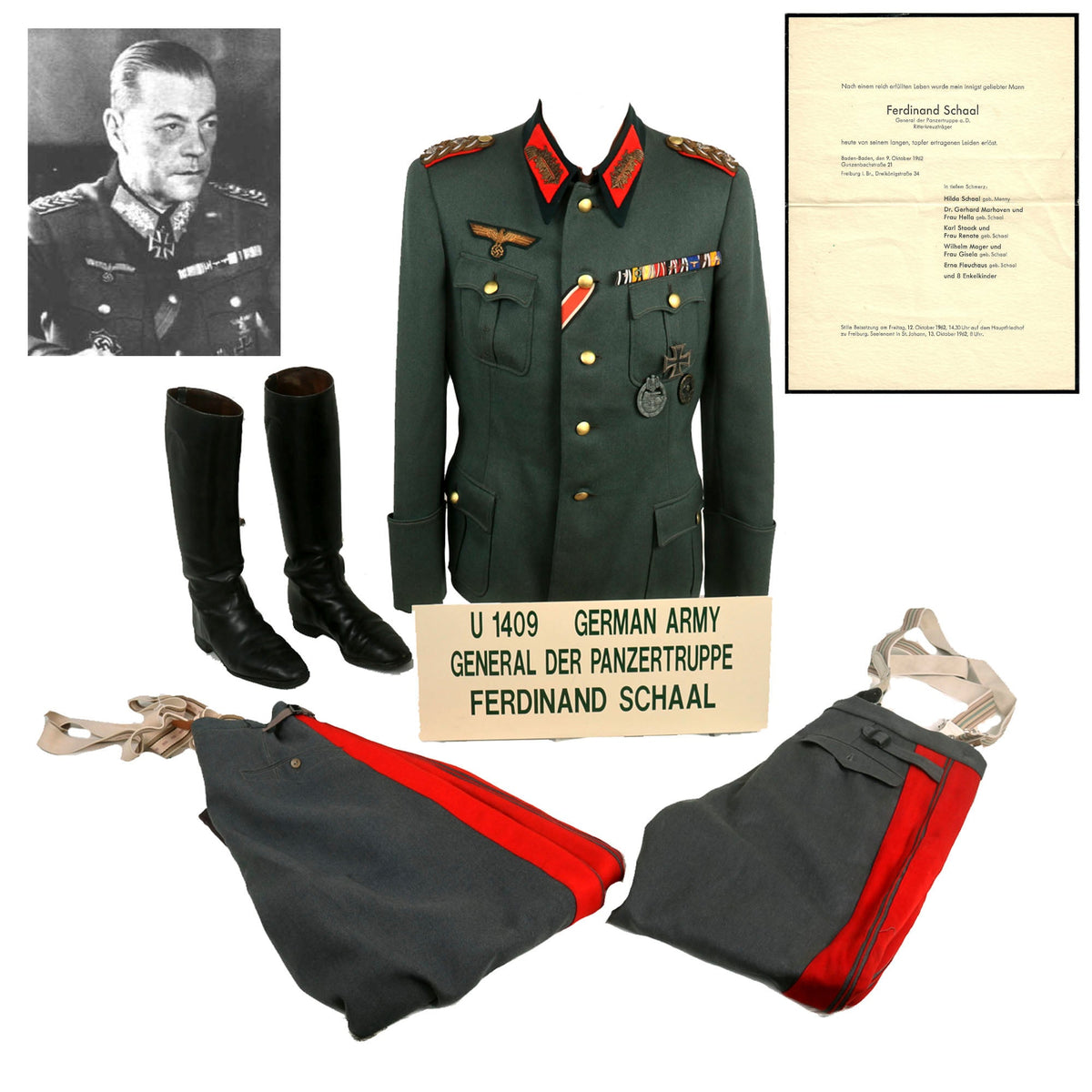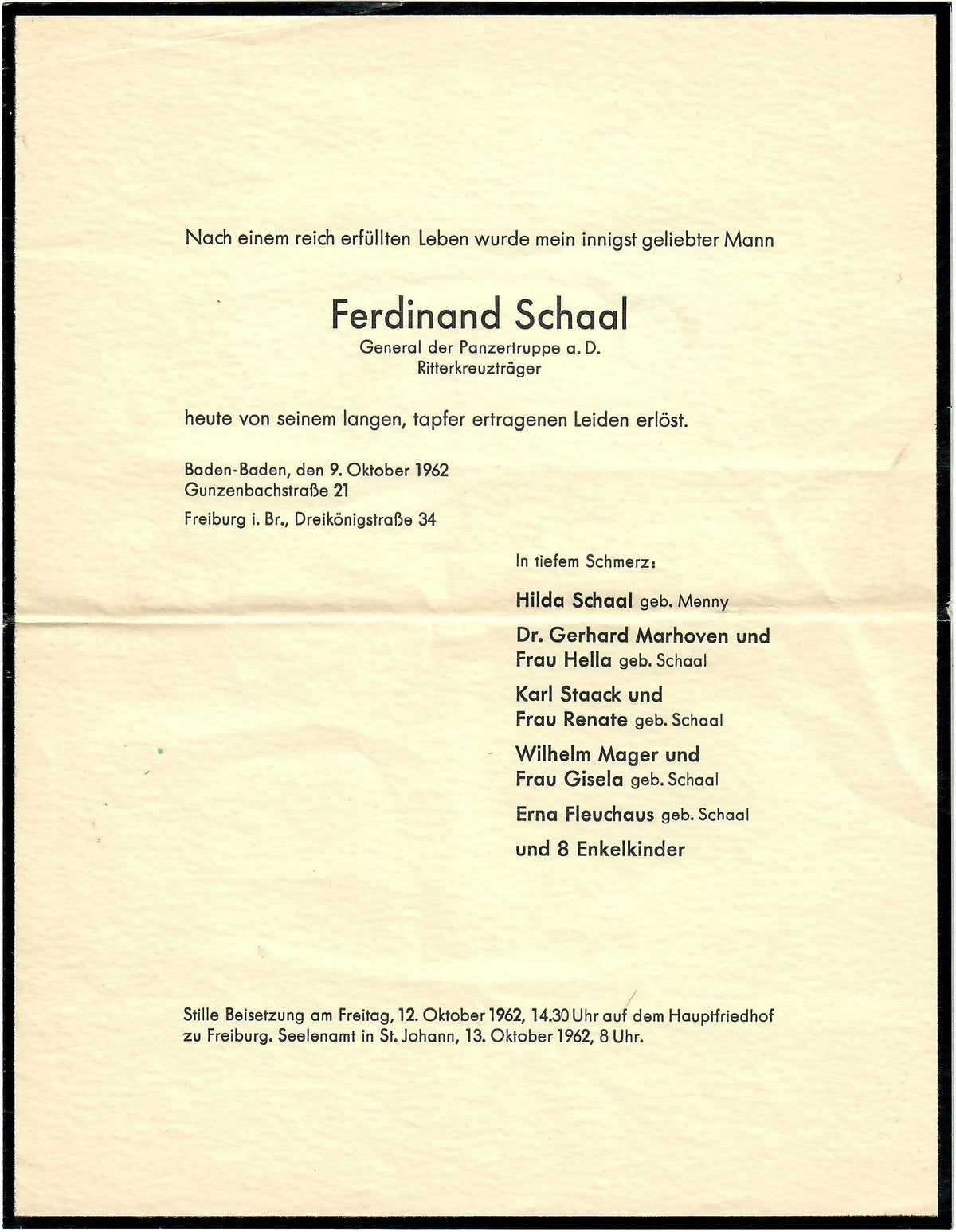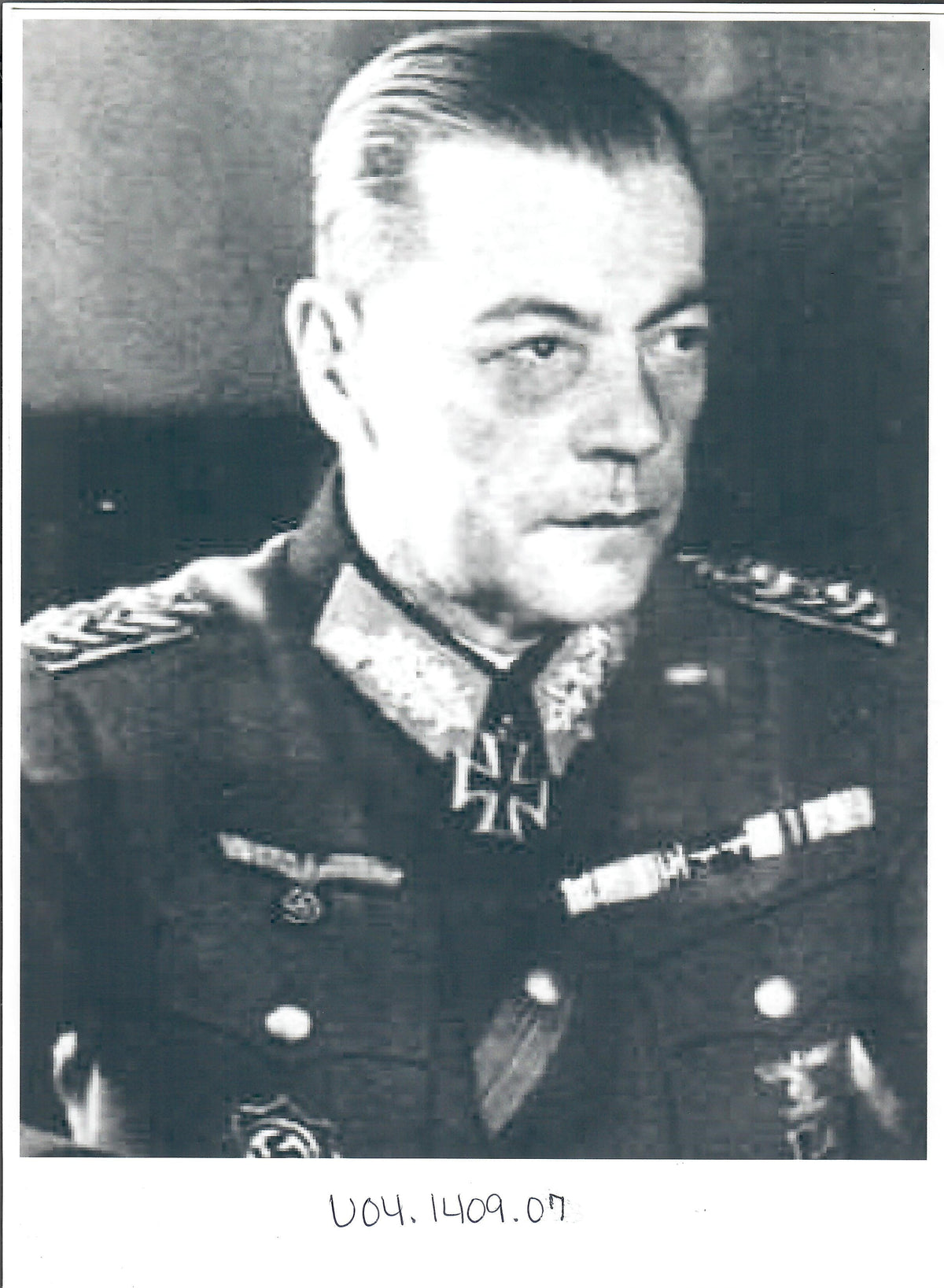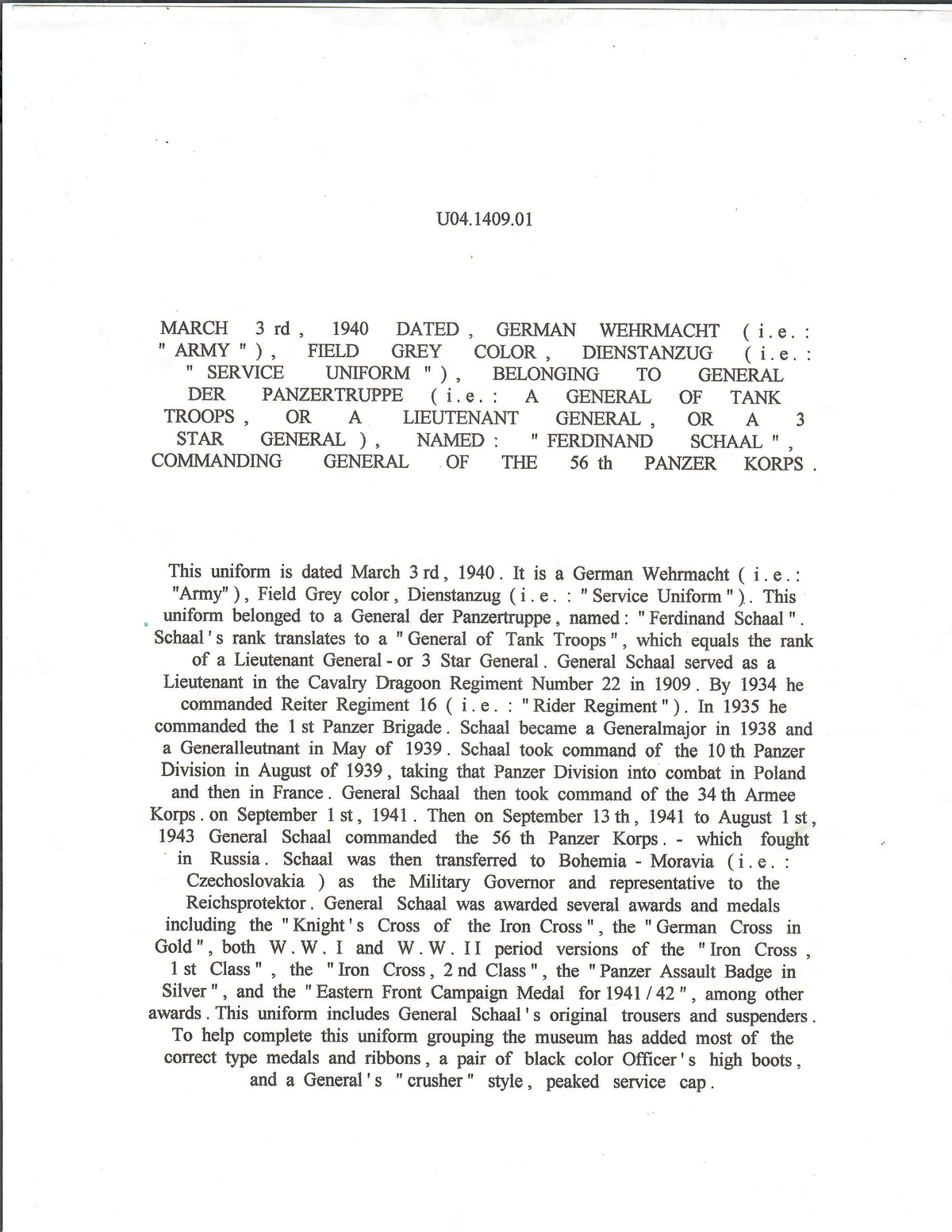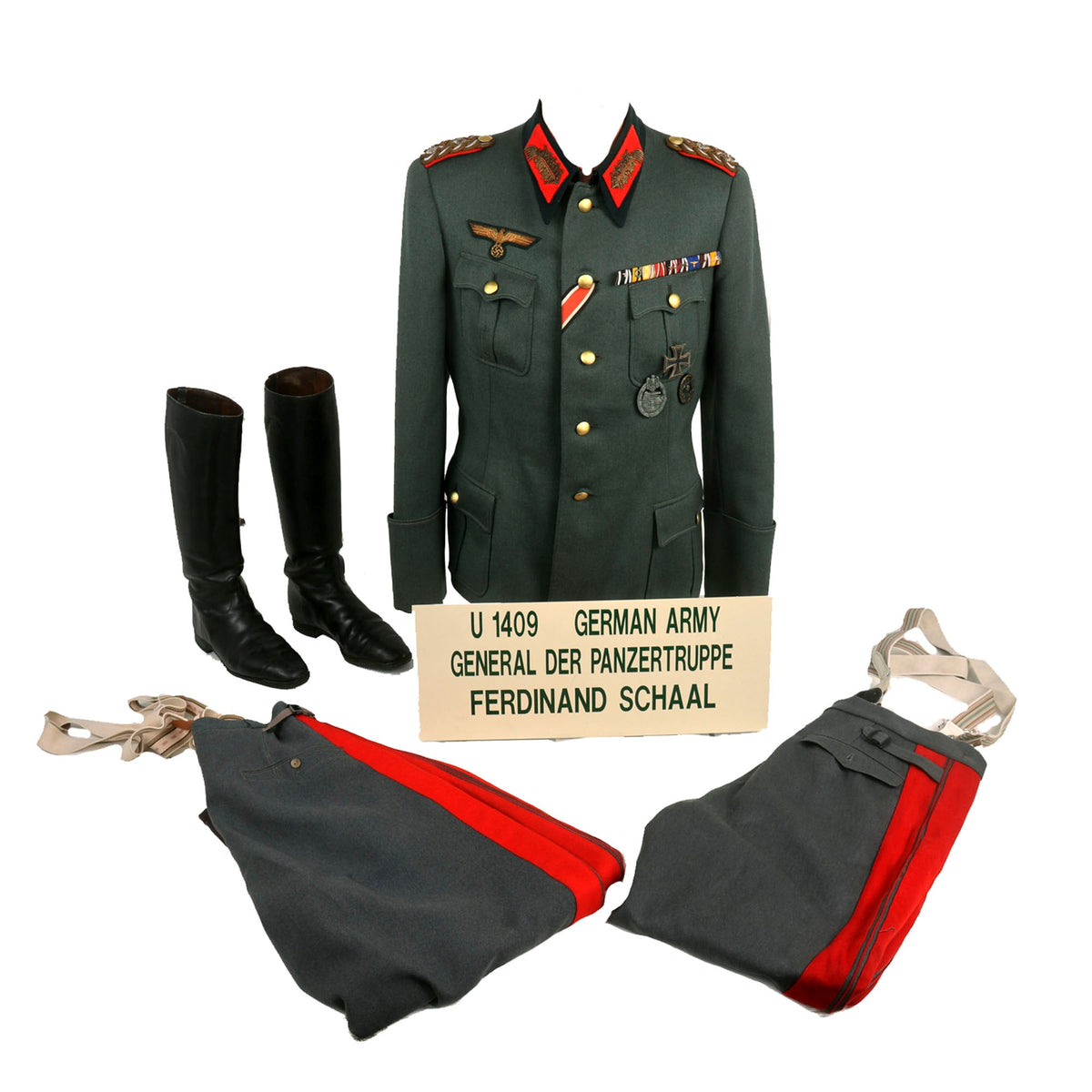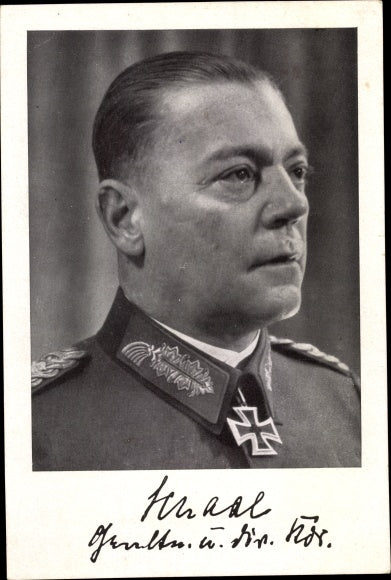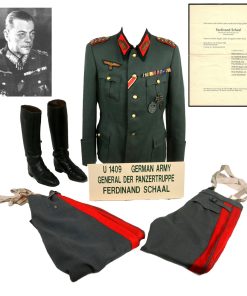Original German WWII 10th Panzer Div. & LVI Panzerkorps Commander General der Panzertruppen Ferdinand Schaal Uniform Set – Formerly Part of the A.A.F. Tank Museum Original Items
$ 14.995,00 $ 3.748,75
Original Items: One-of-a-kind set. Ferdinand Friedrich Schaal (7 February 1889 – 9 October 1962 was a German Panzertruppe General in the Heer Army during World War II, who commanded the 11th Panzer Division and later the LVI Panzer Corps during his WWII service. He eventually rose to the rank of General der Panzertruppe (Lt. General), and was then named the Military commander of the Protectorate of Bohemia and Moravia in August 1943, after which he did not hold any further military commands. He was a recipient of the Knight’s Cross of the Iron Cross, as well as many other prestigious awards.
Aside from his military exploits, he is also known as being one of the few involved in the Unternehmen Walküre (Operation Valkyrie) assassination plot and coup attempt conspiracy who was NOT executed. As the Military Governor of Bohemia and Moravia, his role was mainly to involve subduing the National Socialist Party in the area and taking control of the protectorate. He was waiting for confirmation on 20 July 1944 on how to proceed, but as the plot failed to assassinate Der Führer, none would come. He would later be arrested and imprisoned for the rest of the war, after which he lived in West Germany until passing away in 1962.
This wonderful German WWII Named Uniform Set came to us from the American Armoured Foundation, Inc. Tank and Ordnance Memorial Museum. The AAF Tank Museum was a living memorial dedicated to the Tank and Cavalry soldiers of the world. Before 1981 some of the artifacts that make up the AAF Tank Museum was a private collection belonging to Mr. William Gasser. Mr. Gasser felt that his collection would be beneficial in educating present and future generations to the sacrifices made and the technologies gained during war. Therefore, in 1981 the AAF Tank Museum was established as a non-profit charitable organization, and Mr. Gasser’s donated his private collection to the Tank Museum. Mr. Gasser is still active as Volunteer Director and Curator of the Tank Museum and his knowledge of military history has been a great asset to the museum. Unfortunately after 20 years of operation it had to close its doors, which is when this set was acquired.
Born 7 February 1889, Ferdinand Schaal began his military career in 1908, and became an officer in an Imperial German Dragoon regiment. He would later continue his military service as a member of the Reichswehr under the Weimar republic. He was a career soldier, and continued his service after the NSDAP takeover of Germany. He was well-decorated, and the following are just the highlights of his many decorations:
● Iron Cross (1914)
– 2nd Class
– 1st Class
● Cross of Honor for Frontline Fighters
● Iron Cross (1939)
– 2nd Class (spange)
– 1st Class (spange)
● German Cross 1941 in Gold
● Eastern Front Medal
Most notably, he was awarded the Knight’s Cross of the Iron Cross on 13 Juli 1940 as Generalleutnant and commander of the 10. Panzer-Division for actions during the Battle of Sedan during the invasion of France in 1940. It should also be noted that due to his long service he would have qualified for the Wehrmacht Long Service awards, and other awards not listed. The Traces of War website gives a very nice partial listing of his various awards and when they were received. Many of these are represented in the MASSIVE medal bar his uniform bears, which also looks to definitely have Imperial German awards not mentioned on listings that we have. There is also a very nice Iron Cross First class 1939, Panzer Assault Badge, and Black Wound badge attached to the uniform under the left pocket, and also an Iron Cross ribbon installed on the second buttonhole.
The uniform in this set was made for Schaal in March of 1940, when he was a Generalleutnant and Commander of the 10th Panzer Division. It is a lovely bespoke example with a clear maker label inside of the left inside pocket, which reads (handwritten parts italicized):
AVERBECK & BRÖSKAMP
BERLIN W.
——————-
HERR Gen Lt Schaal
Nr. 621 den März 194 0
The writing is faint, but we used an 8x magnifier to confirm. Later when he was promoted to General der Panzertruppe, most likely during 1941, all that was needed was to have the second pip added to the shoulderboards, though it is possible that they were entirely replaced as well.
The tunic is really a great example of a private purchased Wehrmacht Heer Generäle Dienstbluse (General Officer Service Tunic). It is constructed from a fine quality field-gray “whipcord” wool woven exterior, with a silk-rayon blended interior lining. The sleeves are lined with the usual blue / gray striped rayon. The collar is constructed of flaschengrün (dark bottle-green) wool, and is adorned by a set of General grade collar tabs, known as alt-Larisch or Arabesque style, which were used for all General ranks below Feldmarschall. These have the correct red backgrounds with gold bullion embroidery.
The tunic conforms well to the M36 pattern, having 4 pleated pockets on the front with scalloped flaps. All of the pebbled buttons are the correct gold color for a General officer, and all look to be maker marked on the back
Each shoulder is decorated with the sew-on style General der Panzertruppen rank shoulder boards. They are both constructed out of a row of interwoven silver and gold bullion strands in the typical Russian braid style in an interlocking weave pattern ending at a pebbled gilt metal (magnetic) button. There are two rank pips installed, correct for a General der Panzertruppen and other specialized General ranks equivalent to a U.S. Army Lt. General. On the right breast is a fine quality gold bullion eagle, constructed of rolled, twisted, and flat hand embroidered gilt stitching with celeon retaining threads, placed onto a dark green wool backing. It is neatly stitched to the outer layer of fabric.
Along with the tunic there are TWO sets of love General’s breeches / jodhpurs in the correct stone gray (steingrau) color, with red stripes on the side, which come with the correct suspenders. They are in very good shape, and definitely period correct, though they do not have any markings on the inside. Finishing out the set is a lovely set of German WWII officer’s tall jackboots
Along with the uniform are some great additional items that really flesh out this fantastic set, and add lots of wonderful research and display potential. These include:
● An original, 1962 dated Funeral Notice for Ferdinand Schaal, General der Panzertruppe a. D. Ritterkreuzträger. It states the following at the top:
Nach einem reich erfüllten Leben wurde mein geliebter Mann
Ferdinand Schaal
General der Panzertruppe a. D.
Ritterkreuzträger
heute von seinem langen, tapfer entragenen Leiden erlöst.
This translates to “After a richly fulfilled life, my beloved husband Ferdinand Schaal was released today from his long, bravely endured suffering.” It goes on to give a listing of where he passed away, a listing of his surviving relatives, and even gives details of the funeral arrangements at the bottom. We presume that this was acquired by the museum along with the uniform, and it adds some fantastic provenance to the set.
● The original painted metal display placard used when the uniform was owned and displayed by the A.A.F. Tank Museum.
● The original information / inventory listing from the A.A.F. Tank Museum, which gives a very detailed history of Schaal’s military progression during the interwar years and during the war.
● Several printed out period photographs of Schaal, which are unfortunately very low resolution. There are very few period photographs of Schaal for whatever reason, and we have unfortunately not been able to find any better examples. We did find a picture of a signed postcard online, which is not included.
● Various printouts from books about the 10. Pz.Div. and LVI Pz.Kps. that mention Schaal and others, along with some pictures of the General.
We very seldom get uniform sets with such great provenance and research potential. This could become the centerpiece of your WWII collection. Ready to research and display!
Approximate Measurements:
Collar to shoulder: 9.5″
Shoulder to sleeve: 26”
Shoulder to shoulder: 15.5”
Chest width: 20″
Waist width: 19″
Hip width: 21.5″
Front length: 30″
Pants:
Waist: 16.5″
Inseam: 31″
Waist: 17″
Inseam: 26.5″
More Biographical Information on Ferdinand Schaal:
Ferdinand Friedrich Schaal was born on 7 February 1889 in Freiburg im Breisgau, Baden. In April 1939, as part of the lead-up to the invasion of Poland, Schaal was tapped to lead the new 10th Panzer Division. He continued to command that unit through the invasions of Poland, France, and the USSR. On 16 March 1942, as the 10th Panzer Division returned to France from its bloody tour of the Eastern Front, Schaal was given the command of LVI Panzer Corps, which was also stationed in the Soviet Union. He served in that capacity until 1 August 1943, when he became Wehrmacht commander in the military district of Bohemia and Moravia.
Operation Valkyrie
His role in Operation Valkyrie was to involve subduing the National Socialist Party and establishing military control over Bohemia and Moravia. On the evening of 20 July 1944, Schaal waited for clarification on how to proceed from General Friedrich Fromm, a co-conspirator in Berlin. None came, as the assassination attempt had failed and Fromm had decided to betray the other plotters. Schaal was arrested the next day on the orders of Heinrich Himmler and imprisoned. Unlike many other conspirators, Schaal was spared execution, instead being imprisoned until the end of war.
More on German Uniform Tunics
Terms such as M40 and M43 were never designated by the Wehrmacht, but are names given to the different versions of the Model 1936 field tunic by modern collectors, to discern between variations, as the M36 was steadily simplified and tweaked due to production time problems and combat experience.
Field Tunic (Feldbluse) Model 1936
When the NSDAP came to power in early 1933 the Reichswehr, the armed forces of the Weimar Republic, were near the end of a two-year project to redesign the Army Feldbluse (field-blouse). Beginning in that year the new tunic was issued to the Reichsheer and then the rapidly growing Wehrmacht Heer, although minor design changes continued to be made until the appearance of the standardized Heeres Dienstanzug Modell 1936. The M36 tunic still retained the traditional Imperial and Reichswehr uniform color of grey-green “field gray” (feldgrau) wool, but incorporated four front patch pockets with scalloped flaps and pleats (on Reichswehr tunics the lower pockets were internal and angled). The front was closed with five buttons rather than the previous eight, and the collar and shoulder straps were of a dark bottle-green instead of the Reichswehr grey. Compared to the Weimar-era uniforms the skirt of the feldbluse was shorter and the tailoring was more form-fitting due to Germany’s adoption of mechanized warfare: soldiers now spent much time in the confined space of a vehicle and a shorter jacket was less likely to pick up dirt from the seats. It also included an internal suspension system, whereby a soldier could hang an equipment belt on a series of hooks outside of the tunic. These hooks were connected to two straps inside the lining, which spread the weight of equipment without having to use external equipment suspenders. The M36 was produced and issued until the very end of the war, though successive patterns became predominant.
Fast Shipping with Professional Packaging
Thanks to our longstanding association with UPS FedEx DHL, and other major international carriers, we are able to provide a range of shipping options. Our warehouse staff is expertly trained and will wrap your products according to our exact and precise specifications. Prior to shipping, your goods will be thoroughly examined and securely secured. We ship to thousands clients each day across multiple countries. This shows how we're dedicated to be the largest retailer on the internet. Warehouses and distribution centres can be located throughout Europe as well as the USA.
Note: Orders with more than one item will be assigned a processing date depending on the item.
Before shipping before shipping, we'll conduct a thorough inspection of the items you have ordered. Today, the majority of orders will be delivered within 48 hours. The delivery time will be between 3-7 days.
Returns
The stock is dynamic and we cannot completely manage it because multiple stakeholders are involved, including our factory and warehouse. So the actual stock may alter at any time. It's possible that you may not receive your order once the order has been made.
Our policy is valid for a period of 30 days. If you don't receive the product within 30 days, we are not able to issue a refund or an exchange.
You can only return an item if it is unused and in the same state as the day you received it. You must have the item in its original packaging.
Related products
Uncategorized
Uncategorized
Uncategorized
Uncategorized
Uncategorized
Uncategorized
Uncategorized
Uncategorized
Uncategorized
Uncategorized
Uncategorized
Uncategorized
Uncategorized
Uncategorized
Uncategorized
Uncategorized
Angolan Rebel 1970s era 60mm Inert Display Mortar from Angolan Civil War Original Items
Uncategorized
Uncategorized
Uncategorized
Armored Burgonet Helmet & Polearm from Scottish Castle Leith Hall Circa 1700 Original Items
